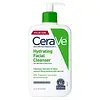What's inside
What's inside
 Key Ingredients
Key Ingredients

 Benefits
Benefits

 Concerns
Concerns

 Ingredients Side-by-side
Ingredients Side-by-side

Water
Skin ConditioningGlycerin
HumectantCetearyl Alcohol
EmollientPEG-40 Stearate
EmulsifyingStearyl Alcohol
EmollientPotassium Phosphate
BufferingCeramide NP
Skin ConditioningCeramide AP
Skin ConditioningCeramide EOP
Skin ConditioningCarbomer
Emulsion StabilisingGlyceryl Stearate
EmollientBehentrimonium Methosulfate
Sodium Lauroyl Lactylate
EmulsifyingSodium Hyaluronate
HumectantCholesterol
EmollientPhenoxyethanol
PreservativeDisodium EDTA
Dipotassium Phosphate
BufferingTocopherol
AntioxidantPhytosphingosine
Skin ConditioningXanthan Gum
EmulsifyingCetyl Alcohol
EmollientPolysorbate 20
EmulsifyingEthylhexylglycerin
Skin ConditioningWater, Glycerin, Cetearyl Alcohol, PEG-40 Stearate, Stearyl Alcohol, Potassium Phosphate, Ceramide NP, Ceramide AP, Ceramide EOP, Carbomer, Glyceryl Stearate, Behentrimonium Methosulfate, Sodium Lauroyl Lactylate, Sodium Hyaluronate, Cholesterol, Phenoxyethanol, Disodium EDTA, Dipotassium Phosphate, Tocopherol, Phytosphingosine, Xanthan Gum, Cetyl Alcohol, Polysorbate 20, Ethylhexylglycerin
Water
Skin ConditioningPropylene Glycol Dipelargonate
EmollientOctyldodecanol
EmollientHydrogenated Polyisobutene
EmollientDicaprylyl Maleate
EmollientStearic Acid
CleansingPersea Gratissima Oil
Skin ConditioningGlycerin
HumectantPropylene Glycol
HumectantPolysorbate 40
EmulsifyingPetrolatum
EmollientTriethanolamine
BufferingHydrogenated Vegetable Oil
EmollientSorbitan Palmitate
EmulsifyingCetyl Alcohol
EmollientButylene Glycol
HumectantGlyceryl Stearate
EmollientIsopropyl Lanolate
EmollientDimethicone
EmollientCarbomer
Emulsion StabilisingSodium Lauroyl Sarcosinate
CleansingPotassium Cetyl Phosphate
EmulsifyingAllantoin
Skin ConditioningTetrasodium EDTA
Polyperfluoromethylisopropyl Ether
Skin ConditioningBHT
AntioxidantParfum
MaskingBenzyl Alcohol
PerfumingLinalool
PerfumingHydroxycitronellal
PerfumingSodium Benzoate
MaskingChlorphenesin
AntimicrobialMethylparaben
PreservativeEthylparaben
PreservativePropylparaben
PreservativeButylparaben
MaskingTitanium Dioxide
Cosmetic ColorantWater, Propylene Glycol Dipelargonate, Octyldodecanol, Hydrogenated Polyisobutene, Dicaprylyl Maleate, Stearic Acid, Persea Gratissima Oil, Glycerin, Propylene Glycol, Polysorbate 40, Petrolatum, Triethanolamine, Hydrogenated Vegetable Oil, Sorbitan Palmitate, Cetyl Alcohol, Butylene Glycol, Glyceryl Stearate, Isopropyl Lanolate, Dimethicone, Carbomer, Sodium Lauroyl Sarcosinate, Potassium Cetyl Phosphate, Allantoin, Tetrasodium EDTA, Polyperfluoromethylisopropyl Ether, BHT, Parfum, Benzyl Alcohol, Linalool, Hydroxycitronellal, Sodium Benzoate, Chlorphenesin, Methylparaben, Ethylparaben, Propylparaben, Butylparaben, Titanium Dioxide
 Reviews
Reviews

Ingredients Explained
These ingredients are found in both products.
Ingredients higher up in an ingredient list are typically present in a larger amount.
Carbomer is a polymer of acrylic acid. Its main role is to create a gel consistency.
A high amount of carbomer can cause pilling or balling up of products. Don't worry, most products contain 1% or less of carbomer.
Cetyl Alcohol is a fatty alcohol. Fatty Alcohols are most often used as an emollient or to thicken a product.
Its main roles are:
Though it has "alcohol" in the name, it is not related to denatured alcohol or ethyl alcohol.
The FDA allows products labeled "alcohol-free" to have fatty alcohols.
Learn more about Cetyl AlcoholGlycerin is already naturally found in your skin. It helps moisturize and protect your skin.
A study from 2016 found glycerin to be more effective as a humectant than AHAs and hyaluronic acid.
As a humectant, it helps the skin stay hydrated by pulling moisture to your skin. The low molecular weight of glycerin allows it to pull moisture into the deeper layers of your skin.
Hydrated skin improves your skin barrier; Your skin barrier helps protect against irritants and bacteria.
Glycerin has also been found to have antimicrobial and antiviral properties. Due to these properties, glycerin is often used in wound and burn treatments.
In cosmetics, glycerin is usually derived from plants such as soybean or palm. However, it can also be sourced from animals, such as tallow or animal fat.
This ingredient is organic, colorless, odorless, and non-toxic.
Glycerin is the name for this ingredient in American English. British English uses Glycerol/Glycerine.
Learn more about GlycerinGlyceryl Stearate is a mix of glycerin and stearic acid.
It is used to stabilize the mixing of water and oil ingredients. By preventing these ingredients from separating, it can help elongate shelf life. It can also help thicken the product's texture.
As an emollient, it helps soften skin and supports barrier-replenishing ingredients.
In cosmetics, Glyceryl Stearate is often made from vegetable oils or synthetically produced.
This ingredient may not be fungal-acne safe
Fun fact: The human body also creates Glyceryl Stearate naturally.
Learn more about Glyceryl StearateWater. It's the most common cosmetic ingredient of all. You'll usually see it at the top of ingredient lists, meaning that it makes up the largest part of the product.
So why is it so popular? Water most often acts as a solvent - this means that it helps dissolve other ingredients into the formulation.
You'll also recognize water as that liquid we all need to stay alive. If you see this, drink a glass of water. Stay hydrated!
Learn more about Water